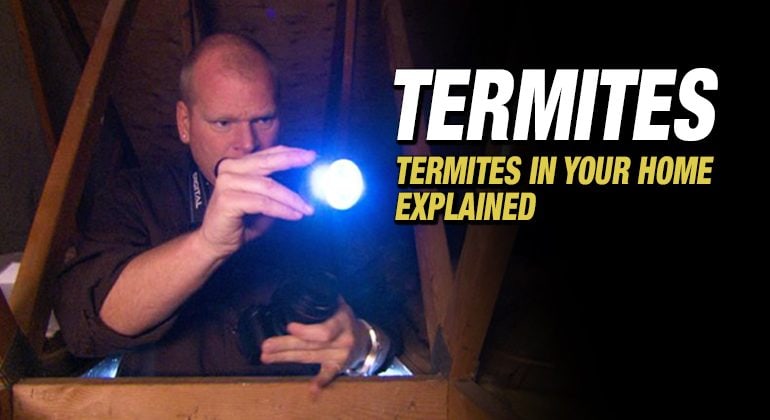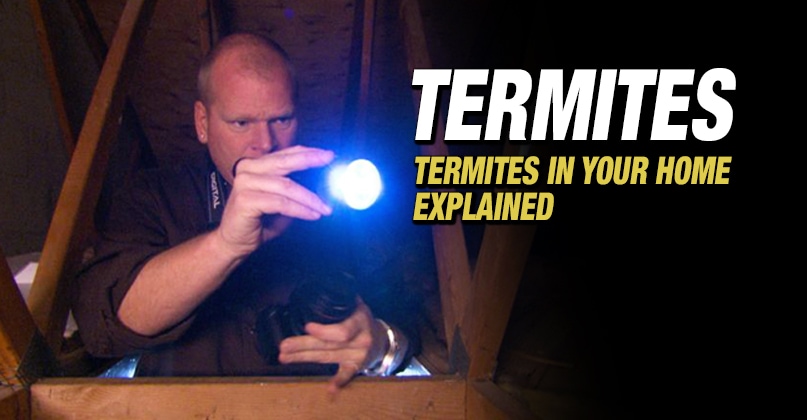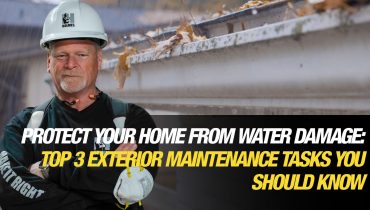If you’ve watched my shows, you know how many surprises we uncover behind the walls. One of the biggest waterproofing mistakes we see on our shows is partial waterproofing. It’s...

Termites In Your Home – Explained
By Mike Holmes
Mike’s Advice / Home Safety & Maintenance
Thursday, May 28th, 2020 @ 12:01pm
Summer is almost here – are you prepared against unwanted houseguests? I’m not talking about the in-laws… I mean unwanted pests like mice, rats, and insects that can sneak in while you’re unaware and cause lasting damage to your home.
I recently received a note from a homeowner in Vaughan, Ontario who has spent over $5,000 dealing with a termite infestation, only to have the problem persist. He’s at his wit’s end, and doesn’t know what to do.
Are Termites A Serious Problem?
The presence of termites is an omen of serious damage in your home. Termites eat wood for food, not just to nest in. They require moisture from soil and soft rotten wood and can tunnel hundreds of feet to find new food sources, like the wood in your house.
They feed on cellulose-based material, including wood, books, boxes, furniture, plants and drywall. They can create nests inside the walls of a home, where they can cause a large amount of damage. They’ll mainly enter through these structural points of the home and forage building materials, insulation, and furniture for food. Termite colonies work 24 hours a day, and infestations can go undiscovered until serious damage is done.

Homeowners rarely see the damage happening because termites eat wood from the inside out. So you usually don’t know you have a termite problem until it’s really serious
What Do Termites Look Like?
There are over 2000 species of termites in the world. Termites can look like carpenter ants, with similar wings and body structures. They tend to have soft bodies with a distinct, hard head region. The color depends on the species and caste of the termites. They could have pale- or cream-colored bodies. Some of them have a large orange or amber head. Other species have dark-colored bodies.
Are You In A Termite Zone?
Termites aren’t just a warm climate problem. While certain areas are more prone to termites than others you can still find them digging around in our Canadian soil. They’re especially thriving in the warmer urban sectors across our country, which is why you might hear about termite infestations in Toronto or Vancouver.
When you’re buying a home, termites should be another item on your list that you’re thinking about when considering a potential neighbourhood. Do your research ahead of time, you’ll be able to avoid buying your ‘dream’ home that turns out to be a major nightmare.
I always say never ignore your environment. If you’re building in an area that’s known to have termites there are construction measures you can take. In fact, according to most local building codes these construction measures are a must.
Drywood termites are usually found in warm, tropical climates such as California, Florida, and Hawaii.
RELATED
I’d rather not buy a house than buy the wrong one, and you should too. Check out RED FLAGS when buying a home.
Signs that You Have Termites
If you find cavities in your wooden structures, filled with what looks like sawdust residue, that could be a sign you’ve got termites. By the way, that’s actually their excrement.
If the wood has holes, but looks clean, it may be the sign of something else, like water damage or carpenter ants (they use wood as a place to nest, not a source for food).
Other signs can include:
- Hollow sounding wood. If you tap your walls and hear a hollow sound, it means termites may have already eaten a large amount of your wall’s interior.
- Even cracked or bubbling paint on exterior walls.
- Termites have wings – but once they’ve found a nest, they’ll discard them. If you find a lot of discarded wings around the home, you know they may have found a good place to nest – and that’s bad news for you.
- termite droppings that look like sawdust (frass)
Because termites need moisture, when they burrow under the surface, they’re adding the necessary moisture that could cause your paint to bubble. While it could be an unrelated moisture issue – when paired with other termite signals, you will want to call a pest control expert.

If you suspect termites, it’s time to bring in a pest control expert, because they know what to look for and how to find it. They’ll also inspect your structures for any other termite related damage.
READ MORE
Mike Holmes’ Painting Tips
WHY IS MY PAINT BUBBLING?
How To Get Rid Of Termites
You can use DIY methods to control small infestations. However, in most cases, hiring an exterminator is the best bet. Termites can live within the walls of a home, so it is best to call an exterminator to assess the damage and find the colony. If you have a large infestation of termites, bring in a professional exterminator. They will have the experience, knowledge and the right products to manage this problem.
How Can I Fight Back Against Termites?
Termites need wood, moisture, and shelter to survive, but you can take steps to prevent termites from thriving around your home.
-
Protect Your Outdoor Structures
If you’re having a deck, or other outdoor structures made of wood built, use a pressure-treated lumber that’s coated with a chemical that repels termites.

Wood should never touch the earth, unless it’s been pressure treated.
Not only that – choose products that are resistant to moisture and rot and make sure you’re giving it the necessary maintenance. It will keep your structure standing strong for a lot longer, and keep the pests away.
-
Fix Your Leaky A/C Unit
Termites love moisture, so if your A/C unit is leaking, get that fixed.
-
Inspect Your Gutters
Your gutters can also be a source for moisture if they’re not properly cleared. If your eavestroughs clog often, consider installing a screen over top to keep water moving clearly through your system.
-
Firewood In Your Home
If you’re like me, you love a roaring fire, especially on a cold night – but if you’ve got a wood-burning fireplace in your home, don’t keep the wood piled up directly against your foundation.
If you find termites, bring in a pro to evacuate your unwanted houseguests. They’ll know what steps to take to get rid of them, and how to keep them from sneaking back in.
-
Avoid Gardens Directly Against Foundation
I don’t like to see gardens directly against a foundation because it can alter the grading so that water flows towards your foundation instead of away from the property. Garden mulch is attractive to termites because it provides the moist protection they need to survive. Having a garden filled with much directly against your foundation is just begging for trouble, if you ask me.
RELATED
As a contractor, I can tell you that good landscaping goes beyond the curb appeal. Landscaping can also protect the exterior of your house from the elements and the sun.
Read useful landscaping tips from a contractor.
Want more tips about your foundation? Watch the video below.
When To Call A Pest Control Expert
It can be tough to be on the lookout for a colony of termites, because often the most prevalent sign that you have them in your home is when you find signs of the damage.
Your best bet is to call a professional pest inspector/contractor. Finding the location and extent of termites in the house is something of an art. Inspectors use a combination of probing, tapping, listening, and looking. Some may use fiber optic scopes that can peer inside a wall.
After finding an insect infestation, a good inspector will recommend one or more options for eradicating the bugs, and discuss the pros and cons of each with you.
When hiring a contractor, do your research and don’t hire the one who offers cash jobs. Here are some tips on how to hire a contractor.








